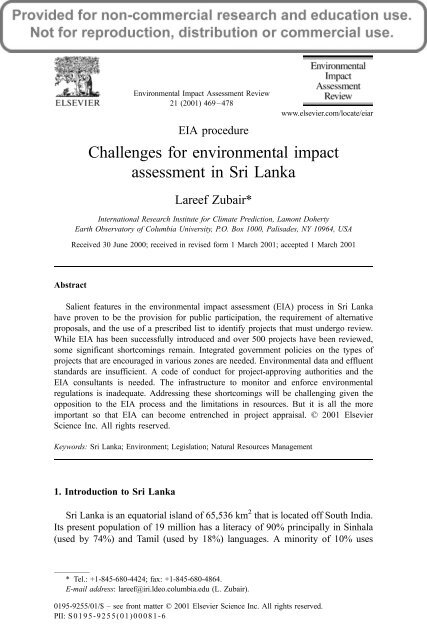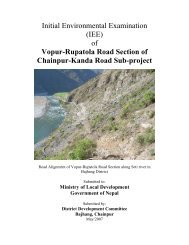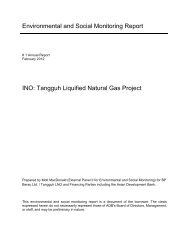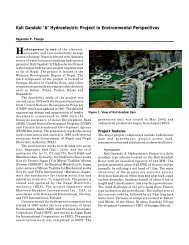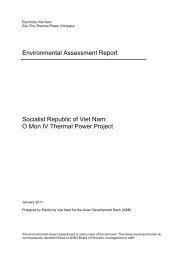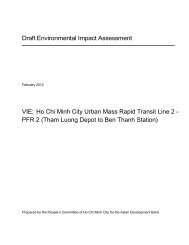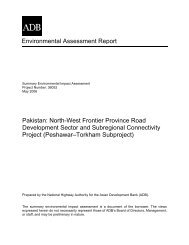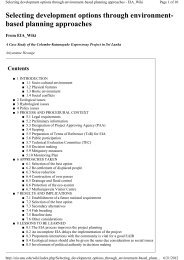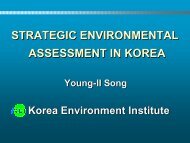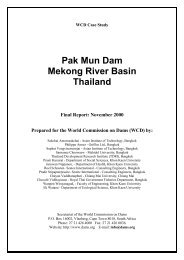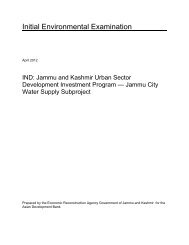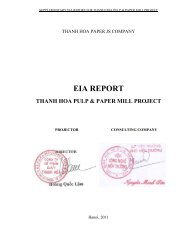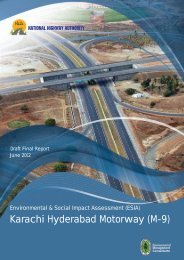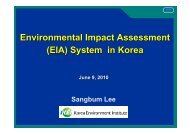Challenges for environmental impact assessment in Sri Lanka
Challenges for environmental impact assessment in Sri Lanka
Challenges for environmental impact assessment in Sri Lanka
You also want an ePaper? Increase the reach of your titles
YUMPU automatically turns print PDFs into web optimized ePapers that Google loves.
Environmental Impact Assessment Review21 (2001) 469–478EIA procedure<strong>Challenges</strong> <strong>for</strong> <strong>environmental</strong> <strong>impact</strong><strong>assessment</strong> <strong>in</strong> <strong>Sri</strong> <strong>Lanka</strong>Lareef Zubair*www.elsevier.com/locate/eiarInternational Research Institute <strong>for</strong> Climate Prediction, Lamont DohertyEarth Observatory of Columbia University, P.O. Box 1000, Palisades, NY 10964, USAReceived 30 June 2000; received <strong>in</strong> revised <strong>for</strong>m 1 March 2001; accepted 1 March 2001AbstractSalient features <strong>in</strong> the <strong>environmental</strong> <strong>impact</strong> <strong>assessment</strong> (EIA) process <strong>in</strong> <strong>Sri</strong> <strong>Lanka</strong>have proven to be the provision <strong>for</strong> public participation, the requirement of alternativeproposals, and the use of a prescribed list to identify projects that must undergo review.While EIA has been successfully <strong>in</strong>troduced and over 500 projects have been reviewed,some significant shortcom<strong>in</strong>gs rema<strong>in</strong>. Integrated government policies on the types ofprojects that are encouraged <strong>in</strong> various zones are needed. Environmental data and effluentstandards are <strong>in</strong>sufficient. A code of conduct <strong>for</strong> project-approv<strong>in</strong>g authorities and theEIA consultants is needed. The <strong>in</strong>frastructure to monitor and en<strong>for</strong>ce <strong>environmental</strong>regulations is <strong>in</strong>adequate. Address<strong>in</strong>g these shortcom<strong>in</strong>gs will be challeng<strong>in</strong>g given theopposition to the EIA process and the limitations <strong>in</strong> resources. But it is all the moreimportant so that EIA can become entrenched <strong>in</strong> project appraisal. D 2001 ElsevierScience Inc. All rights reserved.Keywords: <strong>Sri</strong> <strong>Lanka</strong>; Environment; Legislation; Natural Resources Management1. Introduction to <strong>Sri</strong> <strong>Lanka</strong><strong>Sri</strong> <strong>Lanka</strong> is an equatorial island of 65,536 km 2 that is located off South India.Its present population of 19 million has a literacy of 90% pr<strong>in</strong>cipally <strong>in</strong> S<strong>in</strong>hala(used by 74%) and Tamil (used by 18%) languages. A m<strong>in</strong>ority of 10% uses* Tel.: +1-845-680-4424; fax: +1-845-680-4864.E-mail address: lareef@iri.ldeo.columbia.edu (L. Zubair).0195-9255/01/$ – see front matter D 2001 Elsevier Science Inc. All rights reserved.PII: S0195-9255(01)00081-6
470L. Zubair / Environmental Impact Assessment Review 21 (2001) 469–478English. An elected executive president governs the country and legislation ishandled by a parliament.About 44% of the adults of work<strong>in</strong>g age are employed <strong>in</strong> agriculture, 30% areemployed <strong>in</strong> <strong>in</strong>dustry, and around 25% are employed <strong>in</strong> the service sectors. Someobta<strong>in</strong> their livelihood with fishery, spices, and gems. Twenty-two percent of thepopulation <strong>in</strong> <strong>Sri</strong> <strong>Lanka</strong> lives below the poverty l<strong>in</strong>e (DCS, 1987).Historical records attest to the existence of agriculture (irrigated, ra<strong>in</strong>-fed, andswidden), fishery, hunt<strong>in</strong>g, and gather<strong>in</strong>g start<strong>in</strong>g from be<strong>for</strong>e 3000 BC. Anextraord<strong>in</strong>ary system of large-scale irrigation and metalwork<strong>in</strong>g attests to aflourish<strong>in</strong>g civilization <strong>in</strong> <strong>Sri</strong> <strong>Lanka</strong> until the 15th century AD (Toynbee, 1960).Environmental protection was ensured by a comb<strong>in</strong>ation of traditions, superstitions,royal decrees, and customary laws. Much of the traditional way of liv<strong>in</strong>gwould change after colonial rule by the Portuguese (1505–1658), Dutch (1658–1801), and British (1801–1848).Dur<strong>in</strong>g the period of British rule, the pressure <strong>for</strong> land <strong>for</strong> coffee, rubber, andtea plantations led the <strong>for</strong>est cover to drop from 80% <strong>in</strong> 1820 to 43% <strong>in</strong> 1948.Land settlement, road construction, and irrigation projects by post-<strong>in</strong>dependencerulers and private <strong>for</strong>est clear<strong>in</strong>g led to a further halv<strong>in</strong>g of <strong>for</strong>est cover from 43%<strong>in</strong> 1948 to 23% of late (NARESA, 1991).Rapid <strong>in</strong>dustrialization by state and private sector entities also led to new <strong>for</strong>msof pollution. In addition, there were other alarm<strong>in</strong>g problems such as soil erosion,loss of wildlife habitat, coastal degradation, water pollution, waste disposal, urbanair pollution, mar<strong>in</strong>e pollution, and hydrological and climate change. A grow<strong>in</strong>gawareness of the dimensions of <strong>environmental</strong> degradation led to demands <strong>for</strong>re<strong>in</strong><strong>for</strong>cement of <strong>environmental</strong> regulations (NARESA, 1991).The Stockholm Conference on Environment and Development <strong>in</strong> 1972catalyzed a change <strong>in</strong> government posture regard<strong>in</strong>g the environment. On thatoccasion, the Prime M<strong>in</strong>ister directed that ‘‘although we do not have <strong>in</strong> ourcountry the problems of highly <strong>in</strong>dustrialized countries, it would be prudent to actnow to adopt such measures as are necessary to protect and improve the qualityof our environment’’ (NARESA, 1991).The Central Environmental Authority (CEA) was established <strong>in</strong> 1980.Environmental <strong>impact</strong> <strong>assessment</strong> (EIA) was made mandatory <strong>for</strong> high <strong>impact</strong>projects <strong>in</strong> 1988. Thereafter <strong>in</strong> 1990, the M<strong>in</strong>istry of Environment was established.The new m<strong>in</strong>istry has <strong>for</strong>mulated a National Environmental Action Planand a report <strong>for</strong> the Earth Summit that was held <strong>in</strong> Rio de Janeiro <strong>in</strong> 1993. Theprogress <strong>in</strong> <strong>environmental</strong> conservation has been impeded by an ongo<strong>in</strong>g<strong>in</strong>ternec<strong>in</strong>e conflict <strong>in</strong> the northeast of the island <strong>for</strong> the last 15 years.Of late, there has been a backlash aga<strong>in</strong>st <strong>environmental</strong> regulation. Entrepreneurscompla<strong>in</strong> that <strong>environmental</strong> review has become a bottleneck that holdsup projects that are urgently needed to generate employment. Indeed, thegovernment has attempted to simplify or dilute the legislation and procedures<strong>in</strong> response. Given the difficult circumstance of the <strong>in</strong>troduction of EIA and itssweep<strong>in</strong>g scope, the EIA process has been a success <strong>in</strong> <strong>Sri</strong> <strong>Lanka</strong>. It is argued
L. Zubair / Environmental Impact Assessment Review 21 (2001) 469–478 471here that there are important shortcom<strong>in</strong>gs that should be addressed to preservethe EIA process and its <strong>in</strong>tegrity.In the follow<strong>in</strong>g sections, the history of <strong>environmental</strong> regulations <strong>in</strong> <strong>Sri</strong> <strong>Lanka</strong>is briefly reviewed and the legal basis of EIA is described. Thereafter, the EIAprocedures <strong>in</strong> <strong>Sri</strong> <strong>Lanka</strong> are outl<strong>in</strong>ed and the shortcom<strong>in</strong>gs <strong>in</strong> its implementationare evaluated. F<strong>in</strong>ally, suggestions are made to improve the EIA Process.2. History of <strong>environmental</strong> regulation <strong>in</strong> <strong>Sri</strong> <strong>Lanka</strong><strong>Sri</strong> <strong>Lanka</strong> has a history of <strong>environmental</strong> regulation spann<strong>in</strong>g over twomillennia that took the <strong>for</strong>m of royal decrees and customary law (Weeramantry,1997). From the 16th century, these laws were supplanted by the laws ofPortugal, Netherlands, and Brita<strong>in</strong>. At present, a complex mix of Englishcommon law, the Roman Dutch law, S<strong>in</strong>halese, Muslim, and Tamil customarylaws are accepted.Various <strong>environmental</strong> regulations <strong>in</strong>troduced by the British rulers stillcont<strong>in</strong>ue to be used. 1 After <strong>in</strong>dependence, various legislation relevant to environmentwere enacted 2 and the state ratified a number of <strong>in</strong>ternational treatiesbear<strong>in</strong>g on the environment. 3 In 1976, an expert from the United NationsEnvironment Programme concluded that <strong>environmental</strong> policies and laws weretoo fragmented and too often ignored by planners.When a new constitution was enacted <strong>in</strong> 1978, <strong>environmental</strong> conservationwas enshr<strong>in</strong>ed <strong>in</strong> its Article 18 (‘‘It is the duty of every person <strong>in</strong> <strong>Sri</strong> <strong>Lanka</strong> toprotect nature and conserve its riches’’) and <strong>in</strong> Article 27(14) (‘‘The state shallprotect, preserve and improve the environment <strong>for</strong> the benefit of the community’’).In 1980, the National Environment Act (NEA) was enacted to serve as thefocal po<strong>in</strong>t of <strong>environmental</strong> protection (PS, 1980). Supplementary legislationsuch as the Coast Conservation Act (1981) and National Heritage and WildernessAct (1987) augmented the <strong>environmental</strong> regulations.The United States Agency of International Development (USAID) supportedthe government <strong>in</strong> the implementation of <strong>environmental</strong> regulation. USAID andthe <strong>Sri</strong> <strong>Lanka</strong>n government together conducted the Natural Resources andEnvironmental Policy Project from 1991 to 1997 to assist the sett<strong>in</strong>g up of theEIA process through <strong>for</strong>eign expertise and local tra<strong>in</strong><strong>in</strong>g.1 Among these were those relat<strong>in</strong>g to Nuisance (1862), Wells and Pits (1884), Forests (1907),Plant Protection (1924), Fauna and Flora Protection (1937), Factories (1942), and M<strong>in</strong>es, Quarries,and M<strong>in</strong>erals (1947).2 Fell<strong>in</strong>g of Trees Act (1951), Soil Conservation (1951), International Plant Protection (1951), andProtection of World Cultural Heritage (1972).3 Treaties on Biodiversity, Climate Change, Desertification, Endangered Species, EnvironmentalModifications, Hazardous Wastes, Law of the Sea, Nuclear Test Ban, Ozone Layer Protection, ShipPollution and Mar<strong>in</strong>e Life Conservation, and Wetlands (signed but not ratified).
472L. Zubair / Environmental Impact Assessment Review 21 (2001) 469–478Apart from legislation, the government has produced various policy statementssuch as the Public Investment Plans and sectoral plans <strong>for</strong> land use,coastal zone management, energy generation, regional development, and waterresources management.3. Legal basis of EIA <strong>in</strong> <strong>Sri</strong> <strong>Lanka</strong>The NEA of 1980 recommended the adoption of EIA <strong>for</strong> developmentprojects. In 1988, EIA was made mandatory <strong>for</strong> projects with a significant<strong>environmental</strong> <strong>impact</strong> through an amendment to the NEA.The types of projects that need EIA are listed by gazette notification (GOSL,1993). This list is needed to demarcate the applicability of the law and to ensureits en<strong>for</strong>ceability. This legislation prescribes 31 categories of projects that need<strong>assessment</strong> such as extract<strong>in</strong>g over half a million cubic meters of ground waterper day, build<strong>in</strong>g hotels larger than a hundred rooms, construction of ports, highpollut<strong>in</strong>g <strong>in</strong>dustries, and hydroelectricity projects. In addition, all <strong>in</strong>dustrialprojects that are to be located close to <strong>environmental</strong>, archaeological, or culturallysensitive areas require <strong>assessment</strong>.The EIA has to report on viable alternatives to the project to ensure that<strong>environmental</strong>ly less damag<strong>in</strong>g options are considered too.In addition to the EIA, <strong>in</strong>dustries that discharge effluents are required to obta<strong>in</strong>an <strong>environmental</strong> pollution license from the CEA. Unlike the EIA requirement,this license is required of exist<strong>in</strong>g <strong>in</strong>dustries, too. Local government authorities,under other legislation, exam<strong>in</strong>e projects that do not fall with<strong>in</strong> the prescribed list.This article will conf<strong>in</strong>e itself to the EIA process.4. EIA procedures <strong>in</strong> <strong>Sri</strong> <strong>Lanka</strong>The evaluation of <strong>environmental</strong> <strong>impact</strong> is delegated to various governmentbodies depend<strong>in</strong>g on the nature of the project. 4 The evaluat<strong>in</strong>g agency is referredto as the project-approv<strong>in</strong>g agency (PAA). The project proponent (PP) cannotper<strong>for</strong>m the functions of a PAA. The Coast Conservation Department assessesprojects that affect the coastal zone.Once a project is <strong>in</strong>itiated by a private or state agency, there are several stages<strong>in</strong> an EIA (CEA, 1995, 1996). These are the follow<strong>in</strong>g.The PP provides prelim<strong>in</strong>ary <strong>in</strong><strong>for</strong>mation to the PAA.4 These are the m<strong>in</strong>istries hav<strong>in</strong>g the portfolios of National Plann<strong>in</strong>g, Lands, Irrigation, Transport,Highways, Industries, Hous<strong>in</strong>g, Construction, Fisheries, Aquatic Resources, Agriculture, PlantationIndustries and the Coast Conservation Department, Urban Development Authority, Board ofInvestments, Geological Survey and M<strong>in</strong>es Bureau, CEA, and Ceylon Tourist Board (CEA, 1995).
L. Zubair / Environmental Impact Assessment Review 21 (2001) 469–478 473Scop<strong>in</strong>g is conducted by PAA to determ<strong>in</strong>e the <strong>environmental</strong> <strong>impact</strong>s <strong>in</strong> aprelim<strong>in</strong>ary fashion. The PAA solicits the participation of those affected,queries the PP <strong>for</strong> clarifications, and then decides whether an EIA isrequired or the less comprehensive <strong>in</strong>itial <strong>environmental</strong> exam<strong>in</strong>ation (IEE)would do. It will set the ‘‘Terms of Reference’’ <strong>for</strong> either of these.EIA or IEE report <strong>in</strong> any of the national languages is prepared andsubmitted by the PP. If there is a request from the public, these reports aretranslated to any of the other two national languages. The PAA is requiredto announce <strong>in</strong> national newspapers of all three languages, that theparticular EIA is available <strong>for</strong> <strong>in</strong>spection by the public.The PAA and the CEA review the EIA report. Queries can be directed atthe PP through the PAA. The public is allowed to submit queries andobservations with<strong>in</strong> 30 days. If the project is controversial, the PAA andCEA may decide to have public hear<strong>in</strong>gs.The PAA, <strong>in</strong> concurrence with the CEA, decides as to whether a project isto be allowed.If the project is rejected, an appeal by the PP is allowed.If the project is approved, the PP and the PAA should monitor the affected<strong>environmental</strong> characteristics as set out <strong>in</strong> the EIA.Public participation is a novel feature <strong>in</strong>troduced through EIA <strong>in</strong> projectplann<strong>in</strong>g. The public can participate at the ‘‘scop<strong>in</strong>g’’ stage, review the EIA <strong>for</strong>30 days, request clarifications from the PP through the PAA and may, at thediscretion of the PAA, participate at a public hear<strong>in</strong>g.5. Evaluation of EIA procedures <strong>in</strong> <strong>Sri</strong> <strong>Lanka</strong>On the whole, the <strong>in</strong>troduction of EIA to <strong>Sri</strong> <strong>Lanka</strong> has been successful androbust. Over 500 EIA or IEE reports have been reviewed. The EIA process is wellunderstood throughout the government and by the public. The courts have <strong>in</strong>sistedon its proper adherence <strong>in</strong> important cases such as the recent Eppawela phosphatem<strong>in</strong><strong>in</strong>gproject by American and Japanese corporations that sought to bypass theEIA regulations <strong>in</strong> conjunction with the M<strong>in</strong>istry of Industries (Shockman, 2000;SAELR, 2000). The government was not able to implement a cab<strong>in</strong>et decision toreduce the period <strong>for</strong> public comment from 30 to 14 days as yet (Amaratunga,1996). Although, the government issued a gazette proclamation annull<strong>in</strong>g EIAlegislation <strong>for</strong> energy generation projects <strong>in</strong> 1999, the M<strong>in</strong>ister of Power had topublicly proclaim that EIA would be conducted <strong>for</strong> a 300-MW coal power plant <strong>in</strong>Puttalam due to public protest (IESL, 2000). The EIA process has succeeded <strong>in</strong><strong>in</strong>troduc<strong>in</strong>g a mechanism <strong>for</strong> transparency and public review of projects.The tra<strong>in</strong><strong>in</strong>g programs conducted by the M<strong>in</strong>istry of Environment, CEA, andthe University of Peradeniya has produced over 200 tra<strong>in</strong>ed personnel <strong>in</strong>government, private sector, nongovernmental organizations, and academia. In
474L. Zubair / Environmental Impact Assessment Review 21 (2001) 469–478addition, EIA has been taught at postgraduate level <strong>in</strong> several universities.Notwithstand<strong>in</strong>g these successes, there are loopholes <strong>in</strong> the laws, difficulties <strong>in</strong>the implementation, and <strong>in</strong>adequacies <strong>in</strong> the <strong>in</strong>frastructure needed to support theEIA process that are described below.5.1. Loopholes due to the list of prescribed projectsWhile a prescribed list is needed <strong>for</strong> legal en<strong>for</strong>ceability, the use of a list ofprescribed project scales has led to loopholes by which PPs circumvent EIA.Some entrepreneurs bypass EIA by construct<strong>in</strong>g just below the thresholdspecified <strong>in</strong> the prescribed list. For example, some entrepreneurs have constructed99 room hotels, which is below the 100-room threshold and immediatelythereafter extended the hotels.5.2. Consideration of multiple projects <strong>in</strong> one areaThe EIA legislation also does not have a mechanism to consider thecumulative <strong>impact</strong> of many projects on a region. For example, around Hambantota<strong>in</strong> Southern <strong>Sri</strong> <strong>Lanka</strong>, a ref<strong>in</strong>ery, a central tannery, a caustic soda process<strong>in</strong>gplant, and prawn farm complex were all proposed <strong>in</strong> 1999 and were evaluated<strong>in</strong>dependently. The effluents from all of these enterprises led to a commonestuary. The potential ecological damage to the estuary may not be evident whenprojects are considered <strong>in</strong> isolation.5.3. Consideration of unreasonable alternativesThe serious consideration of reasonable alternatives is a powerful feature <strong>in</strong>EIA evaluation. However, <strong>in</strong> some <strong>in</strong>stances, the best alternatives were deliberatelyavoided. For example, the Upper Kotmale Dam and Hydropower proposal(CEB, 1994) would <strong>in</strong>undate a part of Talawakelle township and <strong>in</strong>volve riskytunnel<strong>in</strong>g. As an alternative, a run of the river reservoir that would reduce thepower capacity from 125 to 90 MW was not considered. Instead, other nonviablealternatives such as power generation with diesel and coal and energy conservationwere cursorily exam<strong>in</strong>ed and dismissed. Similarly, the EIA <strong>for</strong> a tannery <strong>in</strong>Southern <strong>Sri</strong> <strong>Lanka</strong> (CT, 1996) cursorily considered a few alternatives sites alone.5.4. Conflicts of <strong>in</strong>terests <strong>for</strong> the PAAThe regulation that a PP cannot per<strong>for</strong>m the functions of a PAA was tested<strong>in</strong> two <strong>in</strong>stances. The M<strong>in</strong>istry of Highways evaluated the Colombo–Katunayakeexpressway project, which was proposed by an agency under itspurview (RDA, 1992). Similarly, there was a conflict of <strong>in</strong>terest when thePAA <strong>for</strong> the Upper Kotmale Project proposed by the Ceylon Electricity Boardwas its parent m<strong>in</strong>istry. In the latter case, the chief authority of the PAA, the
L. Zubair / Environmental Impact Assessment Review 21 (2001) 469–478 475secretary of the M<strong>in</strong>istry of Power, discarded the f<strong>in</strong>d<strong>in</strong>gs of the technicalevaluation committee and <strong>in</strong>deed canvassed <strong>for</strong> the project. The CEA did notconcur. The PAA appealed to the president of <strong>Sri</strong> <strong>Lanka</strong> to overrule theobjections of the CEA.Another difficulty with the breakup of project-approv<strong>in</strong>g agencies by sector isthat the EIA becomes focused on the sector of the PAA. Thus, the EIA of theUpper Kotmale Project pays less attention to the irrigation, fisheries, and tourismaspects of the project.5.5. Shortcom<strong>in</strong>gs <strong>in</strong> provisions <strong>for</strong> public participationThe provision <strong>for</strong> public participation is a significant strength of the EIAprocess that has been well used <strong>in</strong> <strong>Sri</strong> <strong>Lanka</strong>. In light of its success, there areseveral ways <strong>in</strong> which it needs to be strengthened. Given the difficulties <strong>in</strong>communication, the period allowed <strong>for</strong> public comment of 30 days is <strong>in</strong>sufficientparticularly <strong>for</strong> complex projects. Dur<strong>in</strong>g these 30 days, copies of the EIA reportare available at the local government office and <strong>in</strong> Colombo. In the ord<strong>in</strong>arycourse of events, the affected public often does not come to know of the projector the EIA report until it is too late.The tra<strong>in</strong><strong>in</strong>g of personnel, the guidel<strong>in</strong>es, the discussions on EIA are usually<strong>in</strong> English. Quite often, the affected public is not adequately <strong>in</strong><strong>for</strong>med of theissues at hand or able to <strong>in</strong>terpret the EIA reports. These difficulties arepartially alleviated by public hear<strong>in</strong>gs where explanations can be provided faceto-faceby the PP and EIA consultants. At public hear<strong>in</strong>gs regard<strong>in</strong>g the UpperKotmale Project and the Colombo–Katunayake expressway, discussions turnsout to be <strong>in</strong> the vernacular. Even the EIA consultants express themselves moreclearly. Hence, the limit<strong>in</strong>g of public hear<strong>in</strong>gs to only a few projects is aserious drawback.5.6. Lack of tolerance standardsThe tolerance standards prescribed by the CEA <strong>for</strong> the discharge of effluentsare not comprehensive as yet. The quality of the discharged effluent is onlyprescribed <strong>in</strong> terms of concentration and color, but not volume. Thus, dilution ofeffluents seems to circumvent the need <strong>for</strong> treatment.5.7. Problems with <strong>environmental</strong> dataFrequently, the <strong>environmental</strong> data needed to prepare EIA is not available oris <strong>in</strong>accessible. This has even led to the fabrication of data. Sometimes, thepretext of <strong>in</strong>adequacy of data is used by the PP to short-circuit the EIAprocess. To alleviate these difficulties, the relevant PAA should developdatabases of <strong>environmental</strong> data and identify and obta<strong>in</strong> miss<strong>in</strong>g data thatare required often.
476L. Zubair / Environmental Impact Assessment Review 21 (2001) 469–4785.8. Inadequate post-EIA monitor<strong>in</strong>gQuite often, EIA are approved on the basis of proposed mitigatory steps andmonitor<strong>in</strong>g. Post-EIA monitor<strong>in</strong>g has been poorly implemented so far. Many ofthe <strong>environmental</strong> cells of the PAA do not have full-time staff, space allocation,funds, or equipment (SLAAS, 1995). Even the CEA is understaffed and does nothave much of the technical resources that it needs.5.9. Apprehension of EIA violatorsSome developers bypass the entire EIA process. The majority of the prawnfarms that dot the coastal region <strong>in</strong> the northwestern prov<strong>in</strong>ce are illegal (SLAAS,1995). Due to a variety of problems, such as political <strong>in</strong>terference and understaff<strong>in</strong>g,the EIA legislation has not been used to arrest such illegal prawn farms.The spread of prawn farms without <strong>environmental</strong> safeguards led to theconditions under which disease spread among the prawns rapidly with severelosses to the entrepreneurs.5.10. Professional ethics <strong>for</strong> EIA consultantsThe EIA process relies heavily on the judgment of the EIA consultants <strong>for</strong>three reasons. First, the consultant works with a limited time frame and ofnecessity can consider only a few <strong>impact</strong>s seriously. Second, requisite <strong>environmental</strong>data are not available or are not readily accessible. Third, the adverse<strong>impact</strong>s of some of the <strong>environmental</strong> <strong>impact</strong>s may not be manifest immediately.A PP who is <strong>in</strong>tent on obta<strong>in</strong><strong>in</strong>g a favorable report is able to stack the EIA teamwith particular types of specialists who are predisposed <strong>in</strong> favor of the project. Atpresent, consultants are not taken to task <strong>for</strong> unethical work.6. Suggestions <strong>for</strong> improvementIn <strong>Sri</strong> <strong>Lanka</strong>, the EIA process has succeeded <strong>in</strong> <strong>in</strong>tegrat<strong>in</strong>g <strong>environmental</strong>and other public concerns <strong>in</strong>to the project plann<strong>in</strong>g process. The follow<strong>in</strong>glegal, policy, adm<strong>in</strong>istrative, and technological measures are recommended tothe process.Most projects have been assessed <strong>for</strong> <strong>environmental</strong> <strong>impact</strong> far too late. Ithelps the PPs if <strong>environmental</strong> constra<strong>in</strong>ts are taken <strong>in</strong>to account early <strong>in</strong>the project cycle rather than as an afterthought.The list of prescribed projects should be expanded, its thresholds reduced,and a mechanism to consider the cumulative <strong>impact</strong> of multiple projectsshould be <strong>in</strong>corporated.
L. Zubair / Environmental Impact Assessment Review 21 (2001) 469–478 477 An overall plann<strong>in</strong>g framework should be developed to identify the typesof projects that are to be encouraged <strong>in</strong> each region. In addition, theterritory of <strong>Sri</strong> <strong>Lanka</strong> should be zoned identify<strong>in</strong>g areas that are to beearmarked <strong>for</strong> conservation, culture, wildlife, <strong>in</strong>dustries, and agriculture. Many of the PAA and their EIA cells function without adequate funds,personnel, or wherewithal. F<strong>in</strong>ancial difficulties should be sorted out bylevies, which make the proponent pay <strong>for</strong> essential services. The provisions <strong>in</strong> the NEA <strong>for</strong> multiple PAA <strong>in</strong> the case of multisectoralprojects should be implemented. The officials <strong>in</strong> the EIA cells with<strong>in</strong>m<strong>in</strong>istries should be sensitized as to all <strong>environmental</strong> dimensions ofproject appraisal. The time given <strong>for</strong> public participation should be <strong>in</strong>creased from 30 daysparticularly <strong>for</strong> complex projects rather than decreased. The available <strong>environmental</strong> data should be collated by the relevant PAAand made available. The CEA must highlight shortcom<strong>in</strong>gs <strong>in</strong> <strong>environmental</strong>data and take steps to obta<strong>in</strong> it. The PAA can work out a system oflevies to cover costs and to fund further collection of data. The EIA regulations have to be expanded to provide more guidance onprojects where the PAA has a conflict of <strong>in</strong>terest. There should besafeguards such as <strong>in</strong>creased transparency to ensure that the PAAs are notnegligent or politically <strong>in</strong>fluenced. The priority <strong>in</strong> the field of en<strong>for</strong>cement is to make sure that those whobypass EIA review are apprehended. Unethical conduct of EIA consultants should be monitored. A code ofconduct <strong>for</strong> EIA consultants should be established by the CEA <strong>in</strong>collaboration with professional bodies. Licens<strong>in</strong>g of EIA consultantsshould be considered <strong>in</strong> the future.While there are many shortcom<strong>in</strong>gs <strong>in</strong> the EIA process, given the shakypolitical support <strong>for</strong> the process, it will be prudent to address the leastcontroversial shortcom<strong>in</strong>gs first.ReferencesAmaratunga GK. Address of chairman of CEA at EIA workshop at Randenigala. CES-News, Centre<strong>for</strong> Environmental Studies, University of Peradeniya, 1996.Central Environment Authority (CEA). Guidel<strong>in</strong>es <strong>for</strong> implement<strong>in</strong>g the EIA process. Colombo: CEAPublication, 1995.Central Environment Authority (CEA). Guidel<strong>in</strong>es <strong>for</strong> scop<strong>in</strong>g. Colombo: CEA Publication, 1996.Central Tanneries (CT). Bata-Atha Tanneries EIA report. Colombo: M<strong>in</strong>istry of Industries, 1996.Ceylon Electricity Board (CEB). Upper Kotmale Hydropower Project EIA report and addendum.Colombo: CEB, 1994.Department of Census and Statistics (DCS). Statistical pocket book of the democratic socialist republicof <strong>Sri</strong> <strong>Lanka</strong>. Colombo: DCS, 1987.
478L. Zubair / Environmental Impact Assessment Review 21 (2001) 469–478Government of <strong>Sri</strong> <strong>Lanka</strong> (GOSL). Gazette of the Democratic Socialist Republic of <strong>Sri</strong> <strong>Lanka</strong>.Colombo: GOSL, 1993 (June 24).Institution of Eng<strong>in</strong>eers <strong>Sri</strong> <strong>Lanka</strong> (IESL). Proceed<strong>in</strong>gs of sem<strong>in</strong>ar on proposed coal power plant, IESLAuditorium, Colombo, July 8 IESL, 2000.Natural Resources, Energy and Science Authority of <strong>Sri</strong> <strong>Lanka</strong> (NARESA). Natural resources of <strong>Sri</strong><strong>Lanka</strong>: conditions and trends. Colombo: NARESA, 1991.Parliament of <strong>Sri</strong> <strong>Lanka</strong> (PS). National Environmental Act. Colombo: PS, 1980.Road Development Authority (RDA). Colombo – Katunayake expressway EIA report. Colombo:RDA, 1992.Shockman D. The Eppawela judgement. Island Newspaper. (Colombo) http://www.island.lk/2000/12/01/featur03.html.South Asian Environmental Law Reporter (SAELR). Supreme Court of <strong>Sri</strong> <strong>Lanka</strong> Judgement onEppawela — 2000-06-02, vol. 7, no. 2. Campbell Terrace, Colombo 10, <strong>Sri</strong> <strong>Lanka</strong>: EnvironmentalFoundation, 2000.<strong>Sri</strong> <strong>Lanka</strong> Association <strong>for</strong> the Advancement of Science (SLAAS) Environment Committee. Proceed<strong>in</strong>gsof sem<strong>in</strong>ar on EIA and <strong>in</strong>dustrial development. Colombo: SLAAS, 1995.Toynbee A. In: A study of history, Somervell’s abridgement, vol. 1. New York: Ox<strong>for</strong>d UniversityPress, 1960. p. 257.Weeramantry CG. Separate op<strong>in</strong>ion, Gabcikovo-Nagymaros Project. International Court of Justice.The Hague, 25 September 1997. http://www.icj-cij.org/icjwww/idocket/ihs/ihsjudgement/ihs_ijudgment_970925_weeraman.htm.


